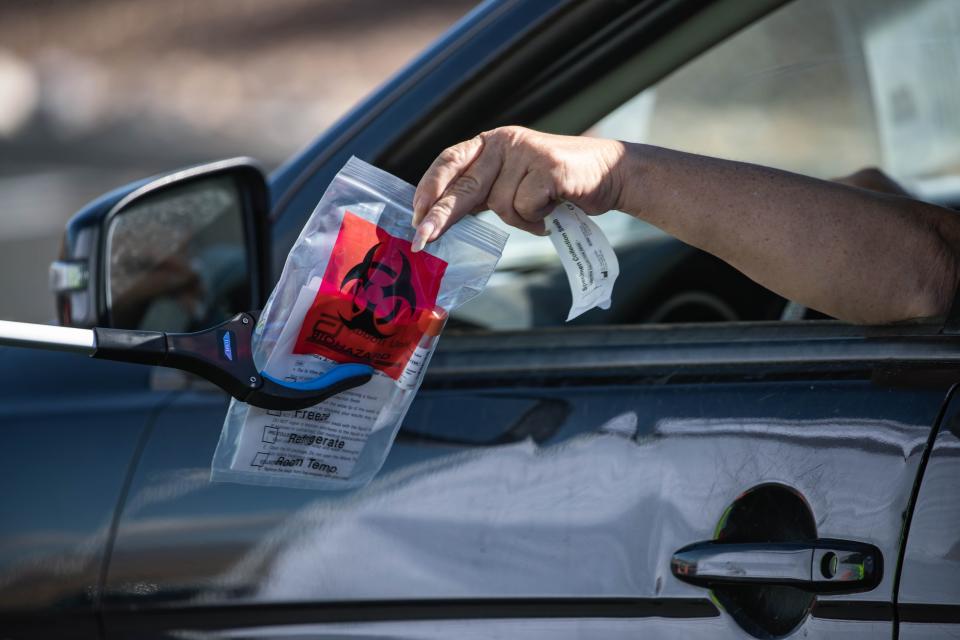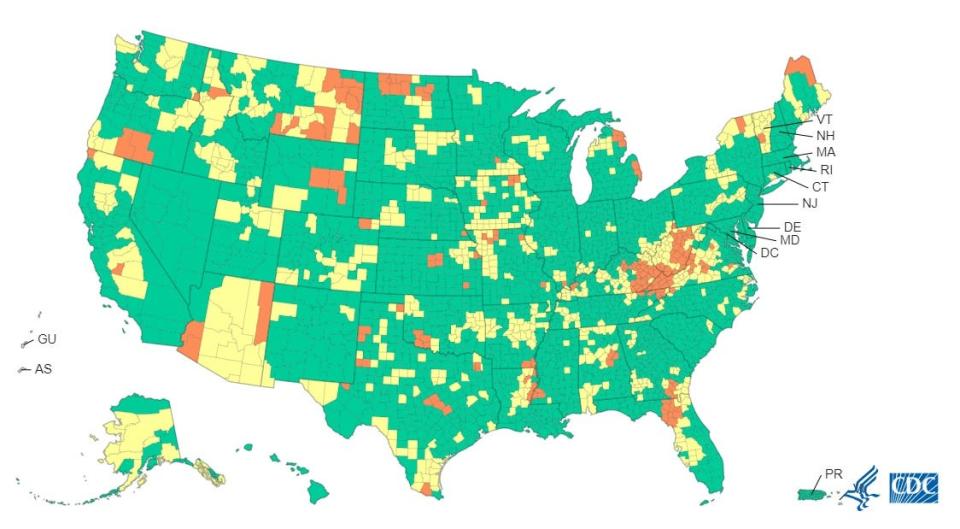What color is your COVID risk? New Mexico, CDC change how they report data
As New Mexico enters its third year with the COVID-19 pandemic, federal and state health officials are changing how data on community spread and its impacts is reported.
Friday, March 11, was the second anniversary of the World Health Organization's declaration of a pandemic over the SARS-CoV-2 coronavirus and of New Mexico's first confirmed cases. It was on that day in 2020 that Gov. Michelle Lujan Grisham first declared a public health emergency.
Last month, New Mexico ended its mandate that residents wear masks in most public indoor spaces, leaving individuals and most businesses and venues to make their own decisions about health risks and appropriate precautions.
On Friday, the New Mexico Department of Health announced changes to how it reports the data informing those decisions.
“Today, we are coexisting with COVID, and changes in our reporting reflect this new stage in the pandemic,” acting state Health Secretary Dr. David Scrase said in a written statement.
More: Vaccinated and test positive? What to know about omicron, COVID for this holiday season.

The department will no longer issue daily news releases tallying new confirmed cases, deaths and hospitalizations. Instead, it will publish daily data on weekday afternoons along with weekly epidemiology reports at its COVID-19 website, http://cv.NMHealth.org.
The reporting will emphasize data on hospitalizations, ventilator use and case fatalities over daily case counts and test positivity rates, a sign of increased reliance on at-home rapid antigen tests as an alternative to PCR tests in which specimens are referred to a laboratory to confirm presence of the coronavirus.
The daily posts will also continue to report daily and cumulative deaths in the state (which reached 7,078 Monday) as well as daily and total confirmed cases, along with the number of reported test results.
Residents seeking information about the disease's spread will also find useful information in the epidemiology reports, accessible at https://cv.nmhealth.org/epidemiology-reports/.
These reports include more details on mortality and hospitalizations, demographic information, county level transmission and surveillance of new variants.

On Monday, the new dashboard reported 108 COVID-19 patients hospitalized, with 13 on ventilators.
There were 28 new deaths reported, but in a departure from previous daily reports, a breakdown of where those deaths took place or how recent they were was not immediately available. County-level breakdowns are available in weekly mortality reports.
The state's official count of confirmed cases was 515,531, with 81 new cases confirmed out of 2,180 state-reported test results. The state subsequently reported 367 new cases were confirmed over the weekend.
Scrase said the state maintained a "constant state of readiness” to respond to new outbreaks of disease, but as mask requirements are eased or dropped, fewer than 50 percent of eligible New Mexico adults have received a booster dose of vaccine and residents are being asked to make their own assessments about the risk of resuming normal activities outside the home.
Making sense of color-coded maps
The state's local community spread reporting uses the color-coded system used by the Centers for Disease Control and Prevention, which currently shows all but five of New Mexico's 33 counties with high or substantial levels of transmission.
COVID vaccine cocktails: A guide to mixing and matching Pfizer, Moderna, J&J booster shots

That's a very different picture than what is presenting on CDC's "community levels" map, which shows most of New Mexico (and the U.S. as a whole) at an encouraging green.
Both maps are updated weekly on the CDC's website but it is largely left to the individual how to make decisions about going out into crowded settings and wearing a mask or not, when a majority of New Mexico counties are red on one map and green on the other.
The "community level" map is a measure of weekly hospital admissions for COVID-19 admissions per 100,000 population, factoring in the percentage of staffed inpatient beds occupied by COVID-19 patients and new cases during the week.
With hospitalizations for COVID-19 rapidly decreasing, New Mexico's 2021 authorization of crisis standards of care phased out last week.
The CDC map shows 30 out of 33 countries at green, but the threshold for staying green is wide: Up to 200 cases per 100,000 population qualifies as "low" as long as local hospitalizations remain under 10 per 100,000 and COVID patients do not occupy more than 10 percent of hospital capacity.

On the other hand, while fewer patients are being hospitalized, the high or moderate level of transmission is a signal that COVID-19 is still spreading rapidly, with people who are immunocompromised or unvaccinated at greatest risk.
The CDC's advice for people in "green" counties is to be vaccinated and boosted, maximize ventilation in shared indoor spaces, and get tested if exposed to someone with a positive case or if showing symptoms. Keeping at-home test kits in supply is recommended as well, particularly for people with more medical vulnerability.
More: UK plans to drop international COVID travel measures, including testing requirements, this week
Meanwhile, health experts worldwide are watching recent increases in cases in Europe and China for signs of new surges or variants of concern.
“We don’t know what’s going to happen next. We don’t know what to expect for sure but we are getting ready,” Scrase said during the virtual news conference marking the second anniversary. “You don’t know that it’s over until it’s really over.”
Algernon D'Ammassa can be reached at 575-541-5451, adammassa@lcsun-news.com or @AlgernonWrites on Twitter.
This article originally appeared on Las Cruces Sun-News: What color is your COVID risk? New Mexico, CDC modify data reporting

